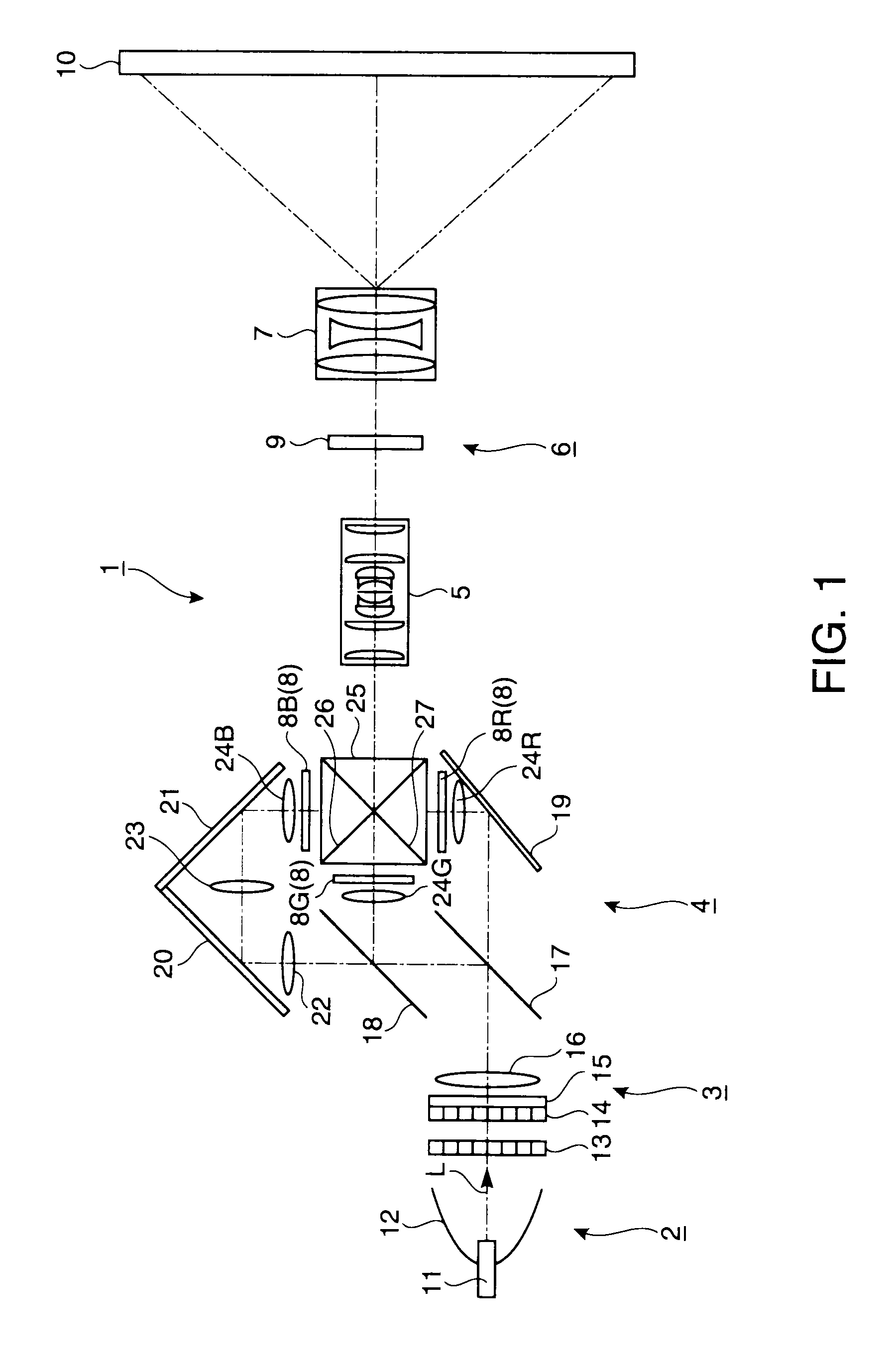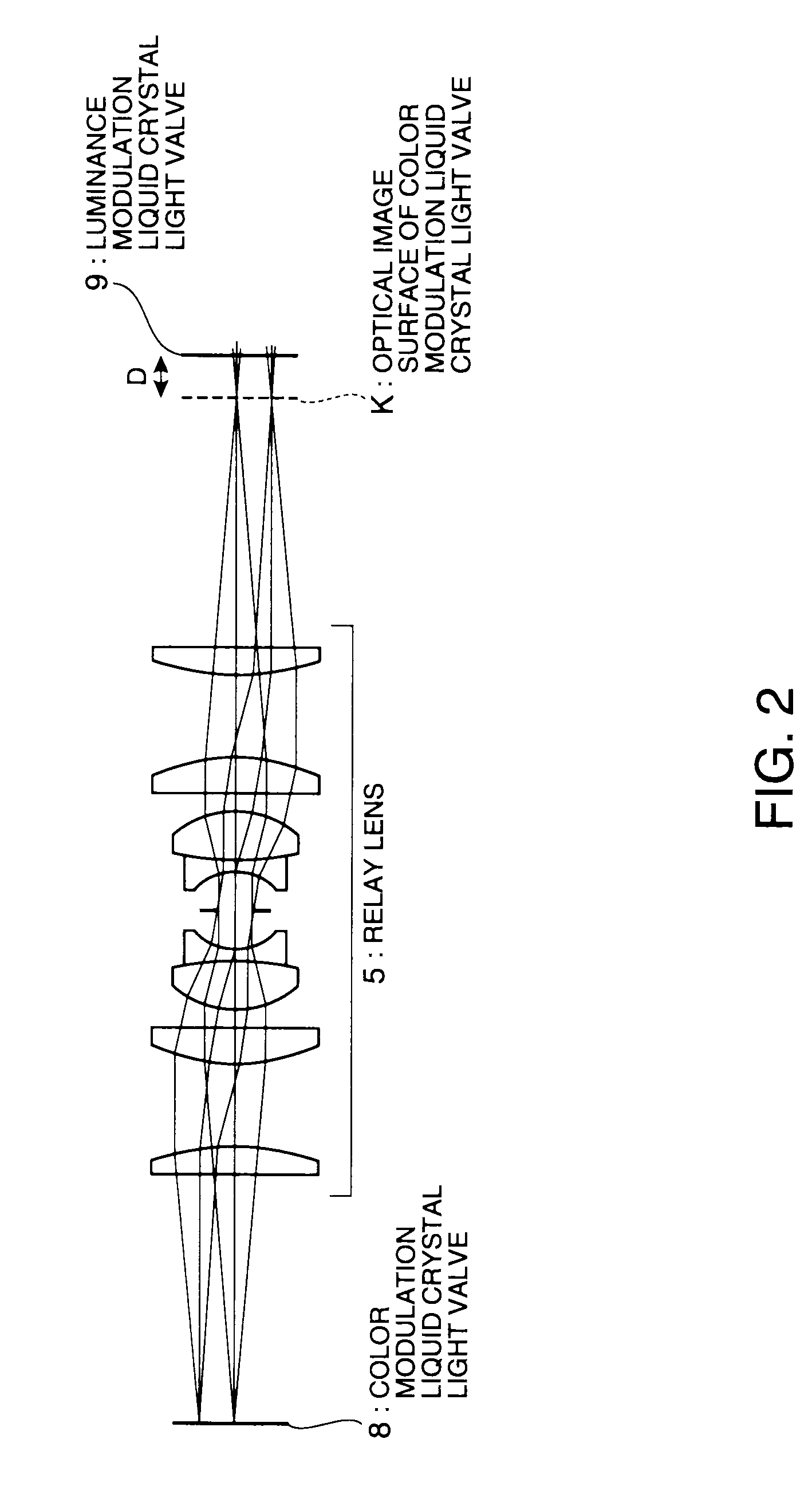Image display apparatus
a technology of image display and display screen, which is applied in the direction of projectors, color television details, instruments, etc., can solve the problems of inability to fully express the cg contents originally possessed, and insufficient shadows and highlights, etc., to achieve reduced moiré effect, high-quality display, and reduced detail sense
- Summary
- Abstract
- Description
- Claims
- Application Information
AI Technical Summary
Benefits of technology
Problems solved by technology
Method used
Image
Examples
first embodiment
[0037]A first embodiment of the invention is hereinafter described with referenced to FIGS. 1 through 8.
[0038]An image display apparatus according to this embodiment is an example of a double modulation system projection type image display apparatus which uses a liquid crystal light valve for both of a first light modulation element and a second light modulation element. The first light modulation element disposed near a light source (upstream side) has three transmission type liquid crystal light valves (color modulation liquid crystal light valves) for modulating different color lights of red light (R), green light (G) and blue light (B). The second light modulation element disposed far from the light source (downstream side) has one transmission type liquid crystal light valve (luminance modulation liquid crystal light valve) for modulating light produced by synthesizing the respective color lights modulated by the first light modulation element.
[0039]FIG. 1 is a view (plan view)...
second embodiment
[0082]According to this embodiment, the distance D between the intermediate image surface K of the color modulation light valve 8 and the pixel surface of the luminance modulation light valve 9 is as small as 180 μm or smaller. However, this distance D can be increased by enlarging the pixel pitch p2 of the luminance modulation light valve 9 from the setting as p1=p2=10 [μm] in the first embodiment.
[0083]For example, when the pixel pitch p2 of the luminance modulation light valve 9 is increased to 30 μm with respect to the pixel pitch p1=10 μm of the color modulation light valve 8 (equal to the pixel pitch in the first embodiment), D≦818 [μm] is set for satisfying h≦1 / 2·p1 and D≦1636 [μm] is set for satisfying h≦p1. Thus, the distance D between the intermediate image surface K of the color modulation light valve 8 and the pixel surface of the luminance modulation light valve 9 can be considerably increased.
[0084]The advantage provided by increasing the distance D between the interme...
third embodiment
[0085]A third embodiment according to the invention is now described with reference to FIG. 9.
[0086]Similarly to the image display apparatus in the first embodiment, an image display apparatus according to this embodiment is a double modulation type projection image display apparatus which uses a liquid crystal light valve for both a first light modulation element and a second light modulation element. The difference in structure between the first embodiment and the third embodiment is that the relay lens for supplying the optical image of the first light modulation element to the second light modulation element is eliminated in the third embodiment.
[0087]FIG. 9 illustrates only a structure around a color modulation light valve and a luminance modulation light valve of the projection type image display apparatus according to this embodiment. In FIG. 9, the same numbers are given to the same components as those shown in FIG. 1, and detailed explanation of those components is not repe...
PUM
 Login to View More
Login to View More Abstract
Description
Claims
Application Information
 Login to View More
Login to View More - R&D
- Intellectual Property
- Life Sciences
- Materials
- Tech Scout
- Unparalleled Data Quality
- Higher Quality Content
- 60% Fewer Hallucinations
Browse by: Latest US Patents, China's latest patents, Technical Efficacy Thesaurus, Application Domain, Technology Topic, Popular Technical Reports.
© 2025 PatSnap. All rights reserved.Legal|Privacy policy|Modern Slavery Act Transparency Statement|Sitemap|About US| Contact US: help@patsnap.com



